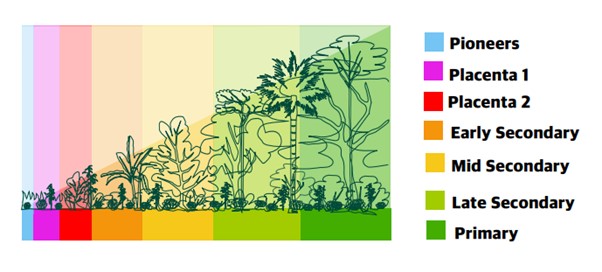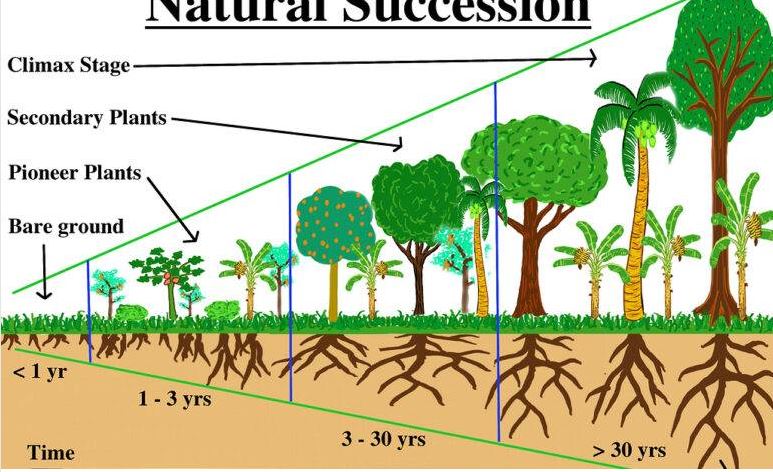By Tim Scott
As with life, understanding the role of SUCCESSION in plant communities is the cornerstone of understanding how regeneration works. This is the most basic land management concept and yet the most overlooked.
Regardless of where your regenerative agriculture journey begins, significant time must be spent first learning the role of plant succession, observing it in your local context and adapting your management to allow nature to heal itself- as it has done for eons.
A plant will grow when the conditions it favours are present and will die out if and when conditions change. High value, palatable grasses for example don’t show up in depleted, hungry, compacted soils. Other plants favour these conditions (pioneers). As a plant grows, it contributes to surrounding ecology and so impacts the conditions of the soil, making way for higher succession species.
Succession in a plant community can be observed both in terms of the variety of plants germinating within a community, but also in terms of age or time those plants have been in the system. Time becomes critical and some transitional species live through various stages of succession. Examples are Camphor Laurel, Brush Box or Olives (in Mediterranean).
In mature communities (like rainforests) successional organisation is more obvious but it occurs everywhere in every situation.
In our coastal “non brittle” environment, there is no excuse for bare earth. This is also the second principle of regenerative farming. Fire, chemical herbicides and tillage are the only way to destroy ground cover and move a system to a degenerative state. Potentially flooding or over-grazing, or more accurately, “under recovery”, may also contribute; but it’s mostly human management that degrades land. Modern “tools” make this degradation happen quicker now than ever before.
When this human-induced degradation happens, after pioneers like moss and lichens, short lifecycle annual “weeds” emerge building biomass and providing the first sugars to the system by reactivating soil micro-biome. These grow fast and tall and cover bare ground trying to repair and regenerate the plant community.
Colonising annual plants (often called “annual weeds” in the cyclical input supply world) work to reestablish a functioning system. Continual extermination efforts result in lower and lower succession, taller and more virulent plants growing, as the system fights to prevent desertification. Ironically, this form of human “management” is often how “invasive” plant species become endemic. You can observe this every day as you drive down the road and see guideposts that have been over-sprayed and have had mid-succession low growing perennial grasses replaced by tall growing early succession annuals.
Next the system moves to short lifecycle perennials like the many “invasive” woody weeds- Tobacco Bush, Caster Oil and Lantana. These valuable protective plant colonies are often relatively short lived. These have an even better penetrative root system accessing deeper nutrients speeding mineralisation as colonies of microbes work their magic in a protected micro-climate.
Over time, again if not interfered with, the “woody weeds” are succeeded in the system by pioneering type trees like Black Wattle or Silky Oak. These have a higher canopy and longer lifecycle in the system. “Mid secondary” succession sees litter accumulation accelerate as pioneering trees die out and there’s a stratification beginning to emerge. Animals are in abundance with larger trees like Brushbox or bigger Eucalyptus species emerging. As we move towards the latter stages of Succession (think Rainforest) or in a grassland, Savanah; large amounts of humus and carbon are cycling with nitrogen availability increasing and canopy height increasing. Blackbutt, large Figs or Flooded gum may all play a part in our systems at this stage. In grasslands, higher order, better quality perennials succeed (think Green Panic and perennial legumes).
The paradigm shift in regenerative agriculture is to “focus on what you want and make the conditions right to out-compete what you don’t want”. Plant succession offers a proven, “Get out of Jail Free” card to do this. Nature is always working for succession, we just have to harness it rather than suppress it.
When understood, the species succession process can be accelerated, but if ignored, a lifetime can be wasted fighting the process with the tools of chemical, fire and tillage before nature can come and fix “management”.
Enjoy life, embrace the complexity of nature, reduce cyclical costs and have a more profitable, regenerative agricultural enterprise by first understanding Plant Succession.
Kandanga Farm Store hosts regenerative agriculture courses and field days throughout the year while tertiary qualified staff educated in many aspects of food production without poison can assist day-to-day in developing and implementing your regenerative plan. See www.kandangafarmstore.com.au or visit the shop Tues-Sat to change your life!

Stages of Succession: Source Syntropia.
